Rivalry Rekindled


photo/Creative Riding
On March 16th, 2017 the on track rivalry between Harley-Davidson and Indian Motorcycle played out for the first time in the 21st century. The long and epic history of both brands was the focus of episode 66 of the Creative Riding Podcast.
The following is a short account put together for the show after having the pleasure of attending the ‘Harley vs. Indian” exhibition’s opening ceremony at the Petersen Automotive Museum. That exhibition is currently on display and runs until 2018. This following story is a curated and cobbled together effort to weave each brand’s histories together into a single timeline. That story is as follows:
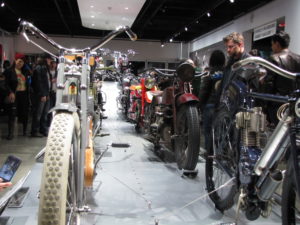
photo/Creative Riding
Indian Motorcycle and Harley-Davidson are by no means the first American motorcycle manufacturers. They were not even the first exporters to other markets. Their lasting imprint on the American psyche and rise to fame is due in part to a changing America, world events and a fierce competitive spirit. Together they became the longest lasting icons of motorcycling’s humble beginnings and harbingers of some of the brightest and darkest moments in automotive history.
This piece is an attempt to showcase their rivalry using historic articles and records from both brands’ own resources, and cleave them together to form the greatest tale in American motorcycling history. This is truly a Clash of the Titians.
George M. Hendee took up bicycle racing at age 16. He won the United States National Amateur High Wheel Championship in 1886, setting a new world record of 2 minutes 27.4 seconds on a half-mile dirt track, which he held until 1892. Hendee was America’s first national cycling champion, winning 302 of the 309 races he entered and dedicating himself to racing and traveling to bicycling events.
Hendee remained involved in bicycling even after he retired from racing, first as a representative for bicycle manufacturers, and later by building his own bicycles. Hendee began making Silver King bicycles at 41-43 Taylor Street in Springfield, Massachusetts in 1895. In 1896, the Hendee & Nelson Manufacturing Company at 478 Main Street in Springfield, Massachusetts was building safety bicycles under the names Silver King for men and Silver Queen for women.
Due in no small part to his racing fame, his line of bicycles sold well. He also sponsored a number of bicycle racers and events throughout New England. Among the racers he sponsored was Jacob De Rosier, a French-Jewish immigrant who would go on to become one of the earliest stars of motorcycle racing.
Another man who had a fascination with two wheels, Oscar Hedstrom built high-quality bicycles that were lighter and more durable than standard bikes. He rented a workshop space in Middletown, Connecticut where he designed and cast engines from his own patterns. He also designed and build a concentric carburetor. While his reputation as a bicycle designer grew, he started to build tandem bicycles with gasoline engines. These were called pacers, and were used to split the wind for racing cyclists. The motorized pacers of that time functioned poorly, but Hedstrom’s design quickly gained a reputation as being very reliable.
Around this same time, a young lad from Milwaukee, WI had developed a passion for the new two-wheeled craze sweeping the nation. In 1895 William Harley first worked at the Meiselbach bicycle factory at the age of 15. Another boy, William’s lifelong friend and neighbor Arthur Davidson, was also enchanted with bicycles and all things two wheels.
William left the bicycle trade and joined his friend Arthur as a draftsman at the Barth Manufacturing Co. around the turn of the century.
1901
During an event at Madison Square Garden in January 1900, Hendee became acquainted with Hedstrom. Through his involvement in bicycle racing, Hendee witnessed first-hand the excellent performance of the motorized pacing bicycle built by Oscar Hedstrom.
Hendee hired Oscar to build gasoline engine-powered bicycles to pace bicycle races. In February, Hedstrom began work on the motorized pacing bicycle at his shop in Middletown. He completed the first motorized bike in May and shipped it the 38 miles to Hendee in Springfield. The machine, and the other two bikes Hedstrom built in 1901, proved to be powerful and reliable, establishing the company’s reputation for outstanding performance.
Later that year the two men to formed the Hendee Manufacturing Company, a partnership with Hendee as president and general manager and Hedstrom as chief engineer and designer. The company’s first factory was opened in downtown Springfield.
Hendee and Hedstrom contracted with the Aurora Automatic Machinery Co. to produce the engines. They produced Indian’s single cylinder chain drive motorcycles, and the first retail sale took place in 1902.
1903
Oscar Hedstrom rode one of the motorcycles to a new world speed record of 56 mph in 1903. The same year, he also won an endurance race from New York City to Springfield and back.
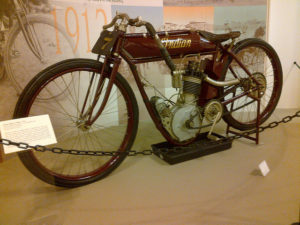
Springfield Indian Museum by Karl Loeffler licensed under CC BY-NC-ND 2.0
Further north, 1903 saw William S. Harley and Arthur Davidson working on their prototype. Arthur’s older brother Walter, an experienced machinist for the Milwaukee Railroad, joined the team that year with the promise of getting the first ride on the motorcycle. When he arrives, there is not much more than a pile of parts however. Never the less, he stays on to help them build and develop the machine. The final Davidson brother, William, having heard what the other boys were up to, decided to bring his skill set as a mechanic and foreman to help the others out.
Later that year they make available to the public the first production Harley-Davidson motorcycle. The bike was built to be a racer. It was based around the second engine that William Harley had designed, and was two years in the making. (The first bike never was produced). William Harley had based the frame off of a loop-type racing frame developed by Merkel, another Milwaukee-based motorcycle manufacturer. The motorcycle used a 440cc single cylinder engine.
1904-05
In 1904, Harley-Davidson built the second prototype, which still exists today in the museum. It was a loop-framed racer with the serial number of #1. Also in 1904 C.H Lang of Chicago becomes the first H-D Dealer. On July 4th, 1905 H-D motorcycle wins a 15 mile race in Chicago with a time of 19:02
1906
In 1906 was a big year for both brands. Indian Motorcycle dealers George Holden (of Cleveland) and Louis J. Mueller (of Springfield) rode an Indian Motorcycle from San Francisco to New York City in 31 1/2 days. At the time that was a record time to travel that distance by motorcycle. On top of that, they made the trip without any mechanical problems.
Also in 1906, the first V-twin factory race bike was built, and Indian Motorcycle continued their impressive string of victories. A version of the racing engine was introduced in consumer models for the 1907 model year, making the 39-ci (633 cc) motor the first American production V-twin motorcycle engine.
While Indian was focused on performance and racing, Harley-Davidson spent 1906 building a new, bigger factory. They also expanded to 6 full time employees.
1907
Indian moved to a larger factory in 1907, allowing the company a chance to end its contract with the Aurora company, and begin producing its own engines. As a result, Indian also expanded its workforce.
Harley-Davidson also expanded. This time to 18 employees. They also double the size of the factory and begin to recruit dealers.
Across the pond, American T.K. Hastings rode an Indian Motorcycle to victory in a 1,000-mile reliability trial in England.

Photo/Creative Riding
1908
Harley finally started making headway in the competition space. Walter Davidson scored 1,000 points at the 7th Annual Federation of American Motorcyclists Endurance and Reliability Contest. Three days after the contest, Walter sets the FAM economy record at 188.234 miles per gallon.
1909-12
Over the next few years, Indian made refinements to its motorcycles. In 1909 they swapped to a “loop” frame that was designed similarly to the racing motorcycles rather than the “diamond” shape of the bicycle frames.
In 1910 Indian Motorcycle changed the front suspension as well as making several engine and ergonomic changes. In 1912 they introduced the swing arm rear suspension and called it the Cradle Spring Frame.
Harley-Davidson was undergoing development alongside Indian Motorcycle. In 1909 Harley-Davidson Motor Company introduces its first V-twin powered motorcycle. With a displacement of 49.5 cubic inches, the bike produces seven horsepower. In 1910 the famous “Bar and Shield” logo was introduced. in 1911 the F-Head was brought into production, and would remain until 1929. Also in 1911 H-D began construction on a six-story factory in Milwaukee, and begins selling motorbikes in Japan.
Those same few years saw great victories for Indian’s racing efforts. In 1911 alone Volney Davis rode from San Francisco to New York City establishing a new record time of 20 days, 9 hours, 11 minutes; Indian Motorcycle racers , Oliver Godfrey, Charles Franklin & A.J. Moorehouse finished first, second, and third, respectively, in the Isle of Man Senior TT; and Erwin G. “Cannonball” Baker won The President’s Race in Indianapolis.
The racing successes and reliability demonstrated by the endurance events helped Indian Motorcycle establish a firm grip in the American psyche as well as in the consumer marketplace. By 1912, Hendee Manufacturing was the world’s largest motorcycle manufacturer.
in 1913, the company’s production peaked at 32,000 units. But after Ford’s Model T was introduced, a car was within the financial reach of many Americans. Motorcycles, once the most economical form of personal transportation, were destined to be marketed as sporting or leisure vehicles, and sales began to fall. Another blow was dealt to Indian Motorcycle that year as chief engineer, designer and co-founder Oscar Hedstrom retired on March 1st.
Meanwhile, on Juneau Ave in Milwaukee, 1913 saw the establishment of Harley-Davidson’s “Racing Department”. In 1914, a few months later, Harley-Davidson would formally enter racing. Harley-Davidson would also unveil a two and three speed rear drive hub in 1914 and 1915 respectively.
A far as Indian goes, May 14,1914 was a special day. “Cannonball” Baker rode from San Diego to the east Coast, breaking Volney Davis’ previous effort with a new record time of 11 days, 12 hours, 10 minutes. The next year, racing on a motorcycle with an early experimental version of a side-valve engine, Baker set the fastest time in a Three-Flag run from Canada to Mexico via California, which he completed in three and a half days.
On June 28th, 1914 – halfway around the globe, a Yugoslav nationalist Serb named Gavrilo Princip assassinated the Archduke Franz Ferdinand of Austria in Sarajevo. This touched off a war in Europe.
Two years later, Hendee stepped down as general manager, but stayed on a company president. The year prior to George’s departure saw new innovations such as electric lights and the first electric start on motorcycle.
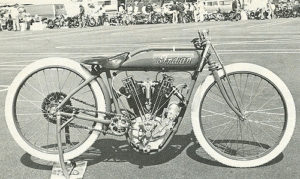
photo/ 1916 Indian 1000cc 8-valve by Insomnia Cured Here is licensed under CC BY-SA 2.0
In 1916 the company unveiled one of it’s most legendary engines -the Powerplus. It was a 1000cc 42-degree V-twin flathead with side valves. More powerful than it’s predecessors, it was capable of rocketing certain models to a top speed of 60 mph. They also introduced a two-stroke single called the Featherweight, which only lasted one year in the lineup.
1916 was also the year that George Hendee, former bicycle racer and manufacturer, co-founder of Indian Motorcycle Company and one of the fathers of American motorcycle racing resigned as company president. He gave up the hustle and bustle of running a large business for a quiet life on a farm.
1917
1917 was the year that the United States entered World War I. A war spawned in Sarajevo by the assassination of Archduke Franz Ferdinand of Austria a few years prior. As with both World Wars, most industries ramped down public operations in an effort to ramp up war support. Indian Motorcycle and Harley-Davidson both supplied the U.S. with supplies and vehicles.
According to Indian Motorcycle’s website, the company provided the U.S. military with nearly 50,000 motorcycles from 1917-1919, most of them based on the Indian Powerplus model.
While Harley-Davidson’s website doesn’t supply numbers, it states that “roughly one-third of all Harley-Davidson motorcycles produced are sold to the U.S. military.” Harley-Davidson also trained military mechanics and developed a school that would later become the Service School.
They also began selling bicycles through their dealer network. Perhaps to provide civilians with an affordable way to commute on two wheels during the war.
The Harley-Davidson models were based on the J series, with a 61 cubic inch F-Head motor producing 15 hp. Indian used the Powerplus Big Twin which was a 61 cubic inch side valve motor producing 18 hp.
Both Harley-Davidson and Indian employed hand shifters and gas headlamps in place of electric ones for simplicity.
The Motorcycles were used extensively as ambulances, supply vehicles, Motor Mobile Infantry (fitted with machine guns), and convoy leads. A famous picture of the first American to ride a Harley-Davidson into Germany is cited as being erroneous on www.ridevintage.com.
Their article on war machines states that Cpl. Holtz was actually captured the day before the Armistice was signed, and released immediately afterward. The photo is of him actually leaving Germany to return to his troop, but the hand-written note on the photo just shows how hard accurately documenting a world war can be.
After WWI and before the Great Depression, motorcycling flourished in the U.S. Harley-Davidson and Indian were only a duo of many brands which sprang up in American Motorcycling’s “Golden Age”.
In 1919 Harley-Davidson introduced a 37c.i. opposed twin Sport model, and by 1920, they are the largest manufacturer worldwide. They have a dealer network over 2,000 strong, and are available in 67 countries.
Over the next 5 years, Indian releases the Scout, Standard, Indian Chief and Big Chief, but didn’t export units or set up the dealer network overseas in the same way that Harley-Davidson had. In 1925 tariffs basically stopped Indian Motocycle Company from exporting to Great Britain. (Note, Motocycle was missing the R on purpose at the time).
Despite the lack of international movement, Indian purchased Ace Motor Corporation in 1927 and released the Indian Ace based on the Ace inline four. The lineup now featured a single, twin and inline four-cylinder engines.
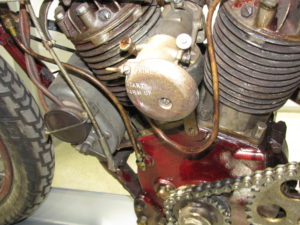
photo/Creative Riding
Harley-Davidson was enjoying success in the marketplace and on the racetrack while Indian tried to stay viable without its original founders.
in 1920 alone, “Red” Pankhurst broke 23 speed records on a Harley-Davidson. The team’s mascot, a hog, also began to get carried around on victory laps. People begin to associate Harley-Davidson with the hog.
In 1928 joe Petrali started racing for Harley-Davidson. He would become one of their most successful factory riders. “Smokin’” Joe Petrali went on to win every single National Dirt Track Championship race in 1935. He would later become the first man in the history of dirt track to win all the races in a series on one motorcycle brand. He continued an amazing career, capturing five consecutive national championship titles from 1932 to 1936, racing on Harley-Davidson and Excelsior motorcycles.
Just before the 1920s close out, Harley-Davidson release their first single cylinder motor since 1918, and they unveil the Flat head in 1929.
Indian drop the single from their line-up and purchase the Hartford Outboard Motor Company that year. They also produced several non-motorcycle related products, but the side ventures didn’t end up helping the company at all financially.
Then in the summer of 1929, the American economy entered a recession. By autumn the stock market had risen while futures seemed bleak. The stock bubble burst on Oct 24th, which became known as “Black Thursday”, and 5 days later on “Black Tuesday”, the rest of the cards began to fall around the stock market.
One year later, the fall of 1930 (a painfully apropos time of year for the Fall of the system to occur) saw the first of four runs on banking establishments. It was a bad time for all, but the motorcycle industry suffered greatly.
1930
E. DuPont of the DuPont car company bought a large share of Indian Motorcycle stock, and ousted the existing management team. He placed members of the DuPont car company in their place. This was the prelude of the Indian Motorcycle company’s troubles with constantly changing ownership, and a problem that would plague them for over half a century.
Harley-Davidson, still run by the same team for the past 25 years, continues to win dirt track and endurance races.
By 1931 Indian Motorcycle and Harley-Davidson are the only remaining motorcycle companies in America. It would remain that way until 1953.
For the next few years, America would drudge through the decade long depression, and consequent economic challenges made sales and development hard for both manufacturers. Harley-Davidson continued it’s winning streak in the racing world, and Indian Motorcycle continued to add, drop and re-configure motors and models in an effort to find a formula that worked.
In 1935, Harley-Davidson licensed blueprints, tools, machines, etc to the Sankyo Company of Japan. Motorcycles were nothing new in Japan, even American ones.
The Jumonji Trading Company had imported the ’94 H&W Motorrad to Japan in 1896. In 1901 the Thomas Auto-Bi appeared followed possibly in 1902 by California and Orient-Aster brand motorcycles. Two Mitchells, made by the Mitchell-Lewis Motor Company in Racine, WI were imported in 1903. Narazo Shimizu designed, built and sold the first NS – a 100% Japanese-made motorcycle, in 1909.
You can see that many American motorcycles, including Harley in 1911 were imported to Japan early on. But now, three and a half decades later, Harley-Davidson was actually licensing their bikes to manufacturers over seas.
Thus- The Rikuo motorcycle was born.
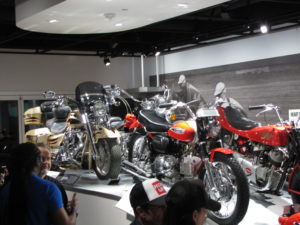
Photo/Creative Riding
During the remainder of the Great Depression, Indian Motorcycle and Harley-Davidson companies continued to race and develop new motors, much as they had throughout the decade long economic siege.
Notable race victories include Indian rider Ed Kretz’s 1937 win of the inaugural Daytona 200- a race on the shores and highway of the historic beach. Harley-Davidson would take the 1939 & 1940 200 trophies with Ben Campanile and Babe Tancrede respectively.
The Jackpine Gypsies started the Black Hills Classic Rally in 1938. A local Indian dealer, Pappy Hoel, helped to spur on the annual event which evolved into the Sturgis Motorcycle Rally.
At the end of the 1930s appeared to be the light at the end of the tunnel. It was more like the light at the end of the rifle barrel.
Just as America was breaking the surface of the dark waters of the Great Depression, the World was plunged head-first into WWII.
According to Indian Motorcycle’s timeline, nearly half of the 10,431 units they made in 1939 were shipped to the French in the onset of the war. They supplied the U.S. and it’s allies with motorcycles for the war with “very few” reserved for civilian use. Harley-Davidson did that same, surrendering almost all motorcycles to the war effort, and reestablishing the Quartermaster School for training mechanics.
After the war neither brand wasted time getting back to production for profit. Indian hit a slight rough patch however, being sold by the DuPont brothers to R. Rogers. Rogers bought Indian and Torque Manufacturing Co. A former Indian engineer worked at Torque and Rogers wanted to steer the company in a certain direction.
Harley-Davidson claim that the service men who were introduced to H-D during the war couldn’t forget them once they got home,
From 1946-48 Rogers toured the country to showcase the sporty new 440cc Scout and 220cc single in the Indian Arrow. He was replaced as president in 1950 by John Brockhouse.
That same year, Arthur Davidson, the last remaining of the founding four passes away. Indian Motorcycle had gone through a number of ownership and leadership changes in 50 years, while all the Harley-Davidson founders worked for the company until there deaths.
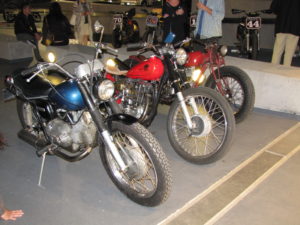
photo/Creative Riding
Harley-Davidson dominated the dirt tracks for the remainder of the Forties, with Jimmy Chann taking three consecutive AMA GNC titles.
Indian won several if the Springfield Miles with Hill and Tuman in the seat, and they ‘dominated” on road courses as well until Indian’s closure in 1953.
Brockhouse Engineering bought the rights to Indian and sold re-badged Royal Enfields under the iconic banner, but Harley-Davidson would be the sole American motorcycle manufacturer for the next 46 years.
From 1950 on, it seemed that Harley-Davidson was synonymous with winning, as they took Grand National Championship after championship. In fact, beginning in 1954, a year after Indian closed, they would take the GNC title for eight consecutive years despite the efforts of Triumph, BSA, and various others.
They would also start to rack up wins at the Daytona 200 on their new KR models.
In 1957 the Sportster was born and fans immediately embraced it’s styling.
1960 saw the Topper scooter. This year was also the birth of Aermacchi Harley-Davidson after they bought half of the Italian firm. The Sprint was a product of the joint venture and debuted in 1961.
The 1960 Daytona 200 featured all Harley-Davidson 750 KRs in the top 14 finishing positions. Roger Reiman won the 1961 200 on a KR. That year the race had moved from the beach to the newly finished Daytona International Speedway, using part of the infield and the banked oval. Bikes started to use full fairings since the bumpy sand was no longer a factor in the race. Don Burnett on a Triumph won the 1962 event. He was the first New Englander to win the Daytona 200 since Babe Tancrede in 1940. Harley-Davidson took it back immediately, and would hold it for the next few years.
The winners, all on 750 KRs were as follows: 1963 – Ralph White; 1964-65 – Roger Reiman; 1966-67 Buddy Elmore & Gary Nixon on Triumphs; 1968-69 – Cal Reborn on 750 KR fully faired.
It wasn’t only the 200 that Harley dominated. In 1965 George Roeder shatters the speed records for Class A and Class C runs, averaging 177 miles per hour in a Streamliner powered by a 250cc Sprint CR racing engine. Harley-Davidson was doing great.
Throughout the 60s, Indian Motorcycle changed hands a couple of times, but nothing real happened with the brand. The only substantial news came in 1967 when a scrappy Kiwi named Burt Munro set a speed record on a bike that started out as a 1920 600cc Scout. The New Zealander made history setting a world speed record of 184.087mph (corrected in 2014) on the Bonneville Salt Flats. Burt was highly under financed, unsupported, and 68 years old when he set the record, which still stands. Because Munro was a man of modest means, he would often make parts and tools himself since he could not afford to have them professionally built. For example, he would cast parts in old tins, make his own barrels, pistons, flywheels, etc. For his micrometer, he used an old spoke.
The end of the 60s was the end of the end of an era. The Vietnam war, the Summer of Love, and Rock n’ Roll were in full swing. Harley-Davidson would merge with American Machine and Foundry in 1969, marking what some consider a very dark spot in the Motor Company’s history. Mert Lawill would take the GNC title that year by conquering dirt tracks and road courses aboard his 750 Harley-Davidson. The Motor Company and the Nation were facing some changes that would shape the next decade, and perhaps the next half century. Some of the press was not so great, like the Hells Angles Altamont incident. That is another story for another time.
From 1970-77 The Indian name was used to sell small displacement bikes from Taiwan and a few Italian mini bikes. Indian’s name would lie dormant for over twenty years after the operations ceased in 1977.
Harley-Davidson, on the other hand, would continue to make waves. The Daytona 200 had run 28 times between 1937 and 1969, skipping the years occupied by WWII. Harley-Davidson had managed to grab 16 victories. That was more than any other brand at the time. In second place was, you guessed it- Norton, with 5 wins. Indian and Triumph shared 3 victories apiece, and Bobby Hill was the lone BSA victor in 1954.
After Rayburn’s victory in 1969, Harley-Davidson would never again win a Daytona 200 title. Yamaha went on to dominate the 70s, and much of the 80s too. The winners after 1970 read like a Japanese phone book. Aside from Dick Mann’s 1971 win on a BSA and Jason DiSalvo’s 2011 checkered aboard a Ducati, the writing was on the wall. It was to be a Japanese-dominated event for the next 37 years.
Something else happened in 1970 though, that made all of that alright: The XR750 was born. That year Cal Rayborn took a single-engine Sportster-powered streamliner to Bonneville and broke a speed record with averages just over 265mph. The XR was an overhead valve bike- a much needed upgrade to stay competitive in racing against the new rules. There was no longer a limit of 500ccs on overhead valve bikes. H-D’s side-valve KR750s had lost their advantage. The XR750 was quickly cobbled together to provide a solution, but in 1972 it was superseded by the superior alloy XR750. “How superior?”, you ask.. Let’s just say that Harley-Davidson only officially switched to the XG-750 in 2017, so nearly 4 decades superior.
The 70s also saw the rise of the cruiser. Had Indian been around to keep Harley-Davidson engaged at the track, things might have been different. For now, customers wanted luxury, and the brand’s bikes were reflecting that. The Cruiser was born.
Just before we step into the next decade, something else significant, or not, happened in 1979. Erik Buell, fresh from getting his engineering degree from the University of Pittsburgh, came to Milwaukee for an interview and “beat my way in the door,” as he puts it.
in 1980, Harley-Davidson debuted its FLT, which looked more like a Honda Goldwing than the nostalgic-styled or batwing-fairing clad cruisers that are normally associated with the motor company. The kevlar belt also replaces the chain.
1981 was a good year for H-D. Scott Parker begins flat track racing for the factory team on the AMA circuit. He will become the most successful racer in Harley-Davidson history, accumulating 93 career victories and winning 9 Grand National Champion titles in a 10-year period.
Executives at the company also sign a letter of intent to purchase it back from AMF. Harley-Davidson can step from the shadows and cast the yoke aside. The company had struggled for a few years, and it was not certain whether they would last through the 1980s.
Harley-Davidson continued to road race with mixed success while dominating dirt track. The brand’s racing efforts were on point, but the consumer side of the company was facing stiff competition and had a poor reputation under AMF’s ownership. In 1983 the Company petitioned the International Trade Commission to issue a five year tariff on motorcycles over 700cc or larger. They alleged that the tariff relief measures would protect them from Japanese dumping stockpiling large inventories of unsold motorcycles in the USA).
In the mid 1980s the Softail debuts, and H-D does what they are famous for now, which is redesigning a more efficient engine and applying it to the latest model line-up to create new models. The brand is also struggling to stay alive and, despite dirt track domination, the race team begins to worry about cuts. To make matters worse, they needed a more powerful bike to compete in World Superbike.
Despite a rough patch, in 1987 Harley-Davidson asks the ITC to end the five-year tariff early. They were gaining confidence.
The next year, the 1200 Sportster was introduced, Harley-Davidson celebrated its 85th anniversary, Scott Parker won his first of nine GNC titles, and development of the VR1000 was begun.
The 1980s came in like a lion and out like a lamb for Harley-Davidson. I guess that could be good or bad if you switched that analogy to the stock market’s symbolic Bear and the Bull. At any rate, things seemed to be getting back on track, and the Motor Company was turning things around.
Erik Buell was a racer through and through, and had left Harley-Davidson in 1983 to pursue his own racing endeavor. He had been racing a Barton since the early 80s, and in 1982, Barton was shutting down and Buell was given the option to purchase the entire stock of spare engines and parts, all drawings and the rights to produce and sell the engine.
Buell’s Barton-powered machines were called RWs for Road Warrior. They were very competitive 750s, and Buell would begin to offer them in late 1984.and Unfortunately the AMA announced that Superbikes would replace the Formula One as the premier road racing class. This meant that all of his work was in vain. He used his connections at Harley-Davidson to get his hands on unused XR1000 racing engines. His new bike would be called the RR1000. He made fifty RR1000s before running out of the XR1000 motors.
Seeing the new 1200 Sportster engines in 1988, Buell began using them to power his sport bikes. The RS1200 and RR1200 were introduced in 1989.
Buell was smuggled onto a cruise ship at the annual dealer meeting in 1987 where he wheeled and dealed with the CEO of the company. Dealers met with Buell and signed on to his crazy idea. In 1993, Harley-Davidson bought a 51 percent interest in the Buell Motorcycle Company.
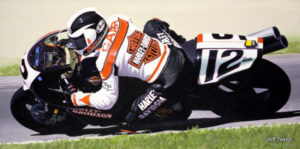
photo/Chris Carr-Harley-Davidson VR1000 Superbike by Jeff Taylor licensed under CC BY-ND 2.0
The next year Harley-Davidson entered Superbike racing with the VR1000, which had been in development for five years.
The 1990s would be a time of expansion and growth for Harley-Davidson, just like it had been 80 years prior. New factories and production lines are built or expanded, anniversaries were had, and the Harley-Davidson branding that Dentists, Lawyers, as well as outlaw bikers can align with, begins to take shape.
1998 was the Company’s 95th anniversary as well as the year that an assembly facility opens in Manaus, Brazil. According to Harley-Davidson’s website, this is also the year that they buy 100% of the Buell Motorcycle Company. Other sources have cited 2003 as the year that they took full control.
1998 is a significant year for another reason. Indian Motorcycle Company of America, a nine-company community effort, tries to get Indian off the ground again for the first time since 1977. This time they open a facility in Gilroy, California and use S&S motors to power the Chief, Scout, and Spirit models. They are seen as little more than nostalgic ass-candy, and the company only lasts a few years.
During the 1990s dirt track’s popularity began to wane. It may have actually started a little earlier than that with the Sportbike making an appearance in the mid 1980s. Admittedly, even Harley-Davidson was trying to develop a Superbike platform at the time. Motocross was also growing by leaps and bounds, and a new thing called extreme sports was slowly building an underground following.
NASCAR’s popularity also began a downturn, and it seemed as though the general public was not interested in races on circles.
Harley-Davidson was still very dominant in the sport, but was focusing their efforts squarely on development and expansion of the brand, both physically and as an industry presence. Custom bike shows and rallies started to gain popularity and grow as well, leading to the Company’s marketing and sales strategies more so than the “win on Sunday, sell on Monday” principle that had benefitted them in the decades prior. Despite disconnecting from their racing heritage on the showroom floor, Harley-Davidson has almost single handedly dome vented the sport of flat track except for a brief run by Honda in the mid-1980s.
On Harley-Davidson’s official timeline, Buell Motorcycles make up the headlines and high points of the early 2000s. This seems a little ironic since the Harley faithful appear to have great disdain for the offshoot marque. The other aberration to brand purists is also released in 2002: The V-Rod.
IN 2006, Fuel Injection becomes standard on most bikes, and trickles in over the next year with ABS following in 2008.
Custom bike shows begin to take off on television, and you can see it reflected on showrooms and streets across the country. Jesse James and Arlen Ness are practically household names, not to mention the outrageous World Biker Build offs that begin to take the scene by storm. Harley-Davidson tries to cash in on the craze with the Rocker.
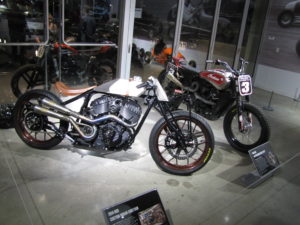
2006-2007 see phenomenal growth in the motorcycle industry. People with a credit score of 236 can buy a mansion and two new bikes. Gas prices hit an all-time high as well leading to even better than expected sales for motorcycles.
In 2008, the sh*& hits the fan as the Global Economic Crisis drops the floor out from Americans and whatever countries bought their packaged debt.
Buell gets canned by Harley-Davidson in 2009. It’s the end for the engineer’s dreams.
Despite being horrible time to make a comeback, a UK private equity form Stellican Ltd. purchases the Indian Motorcycle co. and gives it a go. Their run lasts from 2008 until 2011 when Polaris buys the brand.
Indian unveiled their new lineup at Daytona Bike Week in 2013. The Thunderstroke 111 fired up and proved to be a crowd pleaser. Immediately Harley-Davidson began to work on a new motor. Since there is generally a five year lead time, this meant that they would not have a competitive rival for a couple of years. The Project Rushmore enhancements were already being implemented as well.
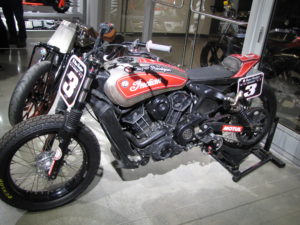
2016- Not to be outdone by Indian’s 106 and 111 cubic inch motors, Harley-Davidson unveils it’s 107 and 114 monsters, delivering almost 100hp out of the 1868cc motor.
2017 will see the racing rivalry that existed between Harley-Davidson and Indian Motorcycle rekindle for the first time in this century. It’s an exciting time to see a staggering giant and an old pioneer come face to face after such a long hiatus.
Alongside the growing rivalry has been the growth of flat track once again. Now even more popular than ever, as builders, customizers, and even OEMs embrace the styling and growing aesthetics of the Hooligan racers and street trackers. It has yet to be seen if Indian Motorcycle Company will hold on long enough to impact Harley-Davidson, but this time it feels real as Polaris has unmistakably chosen to support the name and heritage with which Indian was once synonymous.
The rise of a former titan is nowhere more evident than the tracks where the brand rivalry began so long ago. For the 2017 season, Harley-Davidson and Indian Motorcycle are competing fiercely for sponsorship deals and rider contracts. Indian has poached away the top three riders in the sport of flat track, and Harley-Davidson has responded by assembling it’s own three man team of two-wheeled gladiators. Both brands are sponsoring several races this season, and the introduction of an old nemesis has re-engaged Harley-Davidson in an area that they were taking for granted.
In many ways, they have responded by upping their game, which is beneficial for consumers of the brand and race fans alike. Without Indian’s interjection into the market, and immediately developing a bike for racing, it may have been more of the same for both companies. One thing is certain, as Harley-Davidson has slipped and had several rough patches over the last couple of years, this may be Indian’s chance to strike a profound blow to their great rival. This may be Indian’s chance for retribution, revenge, reprisal..
– Cheers!!
SOURCES
http://www.ridingvintage.com/2012/12/war-machines-american-motorcycles-of-wwi.html
http://www.indianmotorcycle.com/en-us/history
https://www.harley-davidson.com/content/h-d/en_US/home/museum/explore/hd-history/1920.html
https://rideapart.com/articles/history-harley-davidson-founders?page=1
http://www.history.com/topics/great-depression
http://www.hotbikeweb.com/harley-davidsons-roadracing-history
